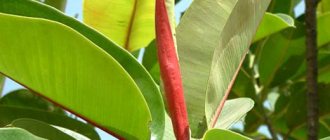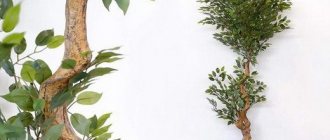Why is pruning needed?
Beginning flower growers are interested in whether partial removal of branches will harm an overgrown bush? Pruning is done to form a beautiful lush crown of the ficus.
Ficus rubbery
Periodic cutting of dry and damaged branches helps keep the plant healthy. Disease prevention includes timely removal of damaged processes. If this is not done, the infection may spread to the entire bush.
Correctly performed manipulation contributes to:
- rejuvenation, restoration of indoor plants;
- formation of a beautiful crown.
Trimming time and tool preparation
How to prune hydrangea correctly in spring and whether it should be pruned
Partial removal and shortening of individual parts, carried out at a time of vigorous growth, will help make the ficus crown voluminous and fluffy.
Trimming tools
A specific period is recommended for each type of pruning. The formation of the crown is carried out from early spring to mid-summer. How to properly form a ficus at home, why can’t you remove parts of branches and foliage in winter?
A popular species among Russian plant growers is the rubber ficus, pruning of which is strictly prohibited from January to March. Coming out of dormancy, the plant begins to sprout shoots from the side where the branches were cut. The bush becomes skewed to one side.
Note! New shoots are formed from the reserves of nutrients left over from the fall. This is harmful to the bush. Actively growing new branches weaken the houseplant.
Do not prune immediately after transplantation. The ficus flower is still undergoing adaptation, and pinching and removing shoots will cause additional stress. After transferring the bush to another pot, you need to perform sanitary pruning.
In the process of forming a bush they use:
- pruner;
- gardening scissors;
- sharp knife (scalpel).
Before manipulation, you need to prepare antiseptic agents:
- garden var;
- alcohol;
- Activated carbon.
Instruments are disinfected with alcohol-containing products and calcined over a fire. Cuts on the trunk and branches are treated with garden varnish. Removal of unnecessary processes is carried out with a sharpened knife. It is impossible to carefully cut off an unnecessary shoot with a blunt instrument. The bark will be “torn” at the cut site. Pathogenic bacteria can enter the trunk through the injured area.
Garden var
Formation of the trunk (trunk)
With the help of proper pruning, you can give a beautiful look to the ficus trunk.
To form a trunk, you need to select a young specimen with a firmly rooted strong straight trunk, cut off all new side branches from it, leaving only 5-6 top ones. Repeat the procedure until the tree reaches the required height.
When the ficus reaches the desired size, you need to pinch the top, which will stimulate the growth and development of lateral branches.
By regularly pinching the top shoots and removing all the leaves at the base of the shoot, it is possible to obtain an adult ficus with a wide spreading crown and an emphasis on the trunk.
General rules for pruning ficus
Removal of healthy branches can only be done during the period of active growth. Before this, the plants need to be fed with nitrogenous fertilizers two weeks before.
How to trim a climbing rose for shaping
Some types of ficus stop their vertical growth by pinching the single central stem. Usually, instead of one trunk, several shoots appear. The rubber ficus does not form lateral branches after pinching.
Sections are made above the kidneys in a horizontal direction. Branches are cut close to the stem. Tall stumps spoil the appearance of the flower. Over time, these short sticks dry out and become a breeding ground for fungi and pests.
It is important to know! Thick woody branches are removed at an angle of 45 degrees, and thin green shoots should be cut straight.
The milky juice is removed from fresh ficus wounds with a cotton swab, then the damaged areas are treated with crushed activated carbon and garden pitch. These measures will disinfect the cut and protect the ficus from infection.
The milky sap of ficus is very thick. If the instruments have been calcined and wiped with alcohol, the wounds on the bark do not need to be treated with varnish and charcoal. When the juice dries, it clogs the cut. Therefore, pruning of rubber ficus can be carried out without antiseptics.
The knife and other items that were used during pruning are thoroughly washed immediately after the manipulation. If this is not done, the frozen juice will be difficult to remove.
How to prune ficus correctly
A lush crown of a ficus is obtained if the shoots are regularly pinched. Pinching the growth points of branches results in the active growth of new side shoots.
Preparing ficus for pruning
In order not to spoil the indoor flower as a result of pinching, the bush is inspected before manipulation. They select weakened, unsightly shoots and think over the shape that should be obtained as a result of processing. The buds located below the branch cuts will become the growth site for future lateral branches.
Additional Information! New shoots will grow in the directions where the buds are directed.
With regular pinching, the size of the leaves decreases. The leaf blades on the side branches have a smaller area than those growing on the central stem.
Ficus Microcarpa - formation features
This specimen at first glance resembles Ficus Benjamin. However, it differs from its relative in that its rhizomes grow very quickly. Thanks to this fact, Ficus Microcarpa becomes an ideal choice for those who are beginning to get acquainted with the art of bonsai. Not being particularly difficult to care for, this specimen will not only attract novice gardeners. It survives well in very humid rooms and is not particularly capricious, although it does not tolerate drafts or sudden temperature changes.
In fact, how to prune Ficus Microcarpa is practically the only thing a beginner needs to learn. To form a lush crown, this tree needs regular pruning several times a year. The best time to prune this type of ficus is spring and summer. During this time, it is necessary to regularly shorten the shoots. Regarding the question of whether it is possible to trim the trunk of a ficus, experts answer unequivocally - yes. This action will increase the thickness and power of the trunk of this small ornamental tree. When forming a bonsai tree from this type of ficus, it is recommended to shorten each branch after 6-10 leaves appear on it, leaving only three or four.
Pruning to rejuvenate the plant
To give new vitality and restoration, it is recommended to trim all damaged branches. Anti-aging pruning is carried out when the plant has been frostbitten or has begun to dry out due to illness.
How to prune Kalanchoe correctly
If the ficus has lost its foliage after hypothermia and the top has begun to die, pruning it to the stump can help. An indoor flower, having gotten rid of the diseased part, will quickly recover due to young growth that will come from living roots. In this way it will be possible to rejuvenate the ficus cariana (fig).
If desired, you can leave a few shoots and grow the flower in the form of a bush. Typically, gardeners select the strongest stem, cut out the surrounding shoots, and then form the plant into a small tree. The choice of shape depends on personal taste.
Note! If you want to get a lot of shoots again, remove them; after a while, root sprouts will appear from the ground. Dwarf ficus trees respond well to such manipulations.
Sick, drying flowers are subjected to radical pruning. Remove all damaged branches. Only 2 buds are left. The cut material is used for cuttings. Long branches are shortened so that there are 4 buds left on them. Two are buried, the remaining ones are left above the soil surface. All sections are pre-treated with activated carbon.
Pruning to rejuvenate the plant
Sanitary pruning
Dry, broken branches, leaves that have begun to turn yellow are removed throughout the year. Poorly developed, diseased shoots should not be left; they spoil the appearance and can become a source of infection for the entire plant.
The flower is periodically inspected. On some varieties of deciduous ficus, the branches become bare after September. Diseased areas can be detected after they have entered a dormant state. Each unhealthy sprout is removed immediately after it is discovered. Pruning is done regularly.
Old and diseased branches become food for fungi. Gradually decomposing, such areas attract pests. Larvae are laid on them. Diseased shoots growing from the soil are removed to the very root.
Formation of the crown and general appearance
The beautiful appearance and fluffiness of the crown are formed in the process of regular painstaking work. The shape of the apical part of the flower is planned in advance. You need to determine how tall the ficus will be. It is important to understand right away whether it will be a standard plant or a fluffy bush. The owner of the flower himself decides how to form the ficus.
When there are too many internal shoots, the crown can be thinned out. They leave buds that are directed not along the trunk, but outward. If the task is to form a round crown, leave an equal number of branches directed horizontally and vertically. The shoots are pruned in a circle, at an equal distance from the point marked in the center.
Formation of the plant crown includes:
- pruning of apical shoots;
- shortening side branches;
- direction of the processes in a certain direction.
Bending and fixing is done using wire, ropes, and pegs. Branches growing in the wrong direction are aligned and secured with tension devices. It is not always necessary to cut off healthy strong shoots at the root. It is better to give them the desired shape. There is no guarantee that the new branches will grow evenly and strong enough.
You can give the desired direction if you bend the branch away from the central trunk; just secure it at the required distance using a spacer or slingshot.
Note! To avoid damaging the bark, foam rubber, cotton wool, or fabric are placed under the tip of the stick.
The crown formed in the form of a ball or cone looks beautiful. The apical part of the ficus can be cut in the form of any geometric figure. Several shoots form a single intertwined trunk with a common crown. Such a tree will decorate an office or home winter garden.
To form a trunk, all shoots are pruned, except for the five apical ones. When the ficus has grown to the desired height, pinch the central stem, then shorten all the branches that have grown beyond measure in a circle. Such manipulations are possible only with young plants.
How to form a crown: popular methods
There are several types of crowns that can be formed by pruning ficus. The most popular of them:
- bush;
- standard;
- spiral;
- arc;
- fence;
- braid
Let's figure out what kind of crowns these are and how to form them.
Bush
- To form a crown in the form of a bush, 2-3 cuttings are planted next to each other.
- When the cutting reaches a height of 15 cm, pinch it from above, leaving more than 5 leaves. This is a stimulating effect for the appearance of 4-5 side shoots.
- When the length reaches 15 cm, the side shoots are cut so that the upper buds are directed outward of the crown. Don’t forget to treat all cuts with charcoal.
- When shoots of the third level reach a length of 15 cm, you will already have a dense bush. If it turns out to be very thick, then it can be thinned out by removing several branches from the middle.
Important! When growing a bush-shaped crown, it is necessary to change the side of the ficus facing the sun so that the crown develops evenly.
The easiest way to green a room.
Spiral
We'll need one escape. Weaving is carried out as follows:
- We plant the cuttings in a pot.
- Depending on the width of the required turns, we select the diameter of the support, which we will install next to the handle. A bamboo stalk or some kind of tube may work for this.
- At a height of 15 cm, the stem is wound onto a support. To obtain uniform turns, inserts are used for a short time. We leave the inserts for a short time so that they do not begin to grow into the stem.
- As soon as the tree reaches the required height, the support is removed.
The spiral looks unusual and decorative.
This video shows how to form a spiral crown:
Arc
- When the plant reaches sufficient height, cut off the top.
- Now you need to bend the plant and secure it, being careful not to break it. In this position, the shoots begin to grow upward.
- When the required shape is acquired, the fixation can be removed.
Stamb
- It is necessary to plant one cutting, during the growth process we remove all the lower shoots, leaving only the 3-4 top ones. With a tree height of 0.5 m, the length of the trunk at the bottom without branches should be 20 cm.
- When the desired height is reached, the top shoot must be pruned by 6-10 cm.
- Next, we begin to form the crown. To do this, we intensively grow side shoots within the crown, and remove everything outside.
- Further formation proceeds like a bush; when pruning, the outer buds should face outward.
Reference. The standard crown can be of different shapes. The most popular are spherical and oval shapes. If you form a spherical shape, then do not forget that the shoots must be the same length.
The standard crown is suitable for houses with high ceilings.
Scythe
For a braid, you need to braid several plants at a distance of 5-10 cm from each other, or you can use one tree with 3-4 side shoots. Work on the desired shape begins when the tree reaches a height of 15 cm:
- If there is one plant, then it is necessary to change the direction of growth of the outer parts of the braid from the central one in opposite directions, tying them to a branch. If there are several plants, then this action is omitted.
- We take the right shoot and throw it over the middle one at an angle of 45 degrees.
- We secure it in this position using threads.
- We wait until the plants stretch out.
- We cross the resulting center with the left shoot.
- As we grow, we repeat the steps.
Make sure that the loops are the same.
This video shows how to braid a ficus crown:
Fence
For the fence, trimmed plants are used. The shoots are planted in a box in one row. In young plants, the top layer of bark is cut off, the juice is wiped off and the stems are connected by tying them. The trees will begin to grow together, the more light there is, the faster they will grow together.
This video shows how to weave a ficus fence:
Creating unusual shapes
The standard ficus looks beautiful, but many novice gardeners do not know how to form its crown. Some ficus trees are grown as small trees. Most of the trunk trunk is freed from side branches. The apical part of the plant is given any geometric shape.
There are interesting options for forming an intertwined single trunk from root shoots. As it grows, several shoots intertwine.
Additional Information! Over time, the stems grow together. To create a single trunk, any braiding pattern is used.
To braid a ficus, you should wait until the shoots grow upward. Young, non-woody shoots can be formed. Depending on the amount of material, you can create weaving in the form of:
- spirals;
- hedge (wattle fence);
- gratings;
- braids.
Unusual trunk shapes
An important design rule. The more complex the shape of the trunk, the simpler and more natural the apical part should look. On a simple single stem, the crown looks harmonious, having the shape:
- spheres;
- cone;
- hemispheres.
How to prune a house ficus so that it is fluffy, the owner makes a decision after a thorough examination of the branches and the location of the buds. If the gardener plans to create a single plant from several shoots, they need to be shortened at the same height. Stems with side branches removed are suitable for weaving. Pinching the apex activates the lateral buds. If the manipulation is carried out regularly, the ficus will form a beautiful lush crown.
How to prune ficus bonsai correctly?
Growing an indoor plant in the bonsai style is a whole science that requires patience, special knowledge and skills. Such compositions look like small works of art. Many experts advise beginners who want to learn this art form to begin their acquaintance with bonsai by growing ficus. This indoor plant is quite unpretentious and has all the qualities for this purpose.
By growing this tree, a beginner will learn how to trim ficus leaves and how to properly care for the plant. It is believed that the most suitable species for creating bonsai will be such species as ficus benjamina, ginseng, panda, ficus sacred, bengal, carika, dark-leaved, retuza and others. It is important for a beginner to learn how to prune a ficus bonsai in order to get a tree with an erect trunk of the correct shape or an original curve in some places. You can also create a plant with an inclined trunk and everted roots. Knowing how to properly trim the roots of a ficus and give it the necessary shape allows you to decorate your home with plants with a forked trunk or a composition of several trees.
To form the desired shape of the crown, you can use special devices that can pull the shoots away from the main trunk, adjust the angle between parts of the plant, and fix the branches in the required position. After some time, all these devices must be removed; the shoots themselves will continue to grow in the given direction.
Activities after pruning
It is impossible to grow a beautiful indoor plant without quality care, which includes:
- regular watering with warm water;
- balanced feeding;
- protection against viruses, bacteria and pests.
Feeding for ficus
Before and after forming the flower, you need to apply fertilizing. To quickly recover, the plant needs nutrients and careful loosening of the soil. When the plant is actively growing, nitrogen fertilizers are chosen.
Important information! Pure organic matter cannot be added. Compost and manure tincture are disinfected. Infection is often introduced with homemade homemade fertilizers.
To avoid pest infestation, ficus leaves can be periodically irrigated with infusion of garlic and onion. This potion is also suitable for watering crops. It is used simultaneously as protection and foliar feeding.
It is not recommended to replant indoor flowers after pruning. Additional stress can cause fragile bushes to die. When transshipment, too long, diseased, rotten roots are removed.
With the right integrated approach to plant care and protection, and high-quality regular pruning, a lush crown is formed. When there is a ficus in the house, how to form a crown is a secondary question. The unpretentious culture tolerates removal and pinching of branches well.
Methods for propagating rubber ficus at home
Cuttings.
The easiest way to propagate ficus elastica. For such propagation, apical and stem cuttings measuring at least 10 cm are suitable. It is best to root cuttings in the soil in a transparent plastic cup using a greenhouse from a bag. The roots that can be seen through the walls of the cup will indicate that the cutting has taken root.
Ficuses with monochromatic leaves take root easily, but variegated leaves take root with difficulty. In order to increase the chances of successful rooting, before planting, the cuttings should be dipped in a root stimulator or heteroauxin.
Leaf propagation.
Ficus leaves root just as easily as cuttings. But you won't expect more from them. The leaf will not sprout, and you will not get an independent plant specimen from it. A leaf with roots will remain a leaf with roots.
Ficus elastica. ©EDI GALVANI ULIANO











